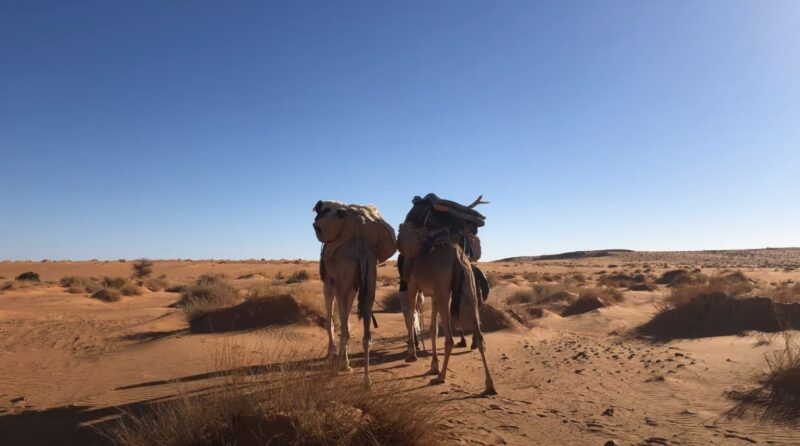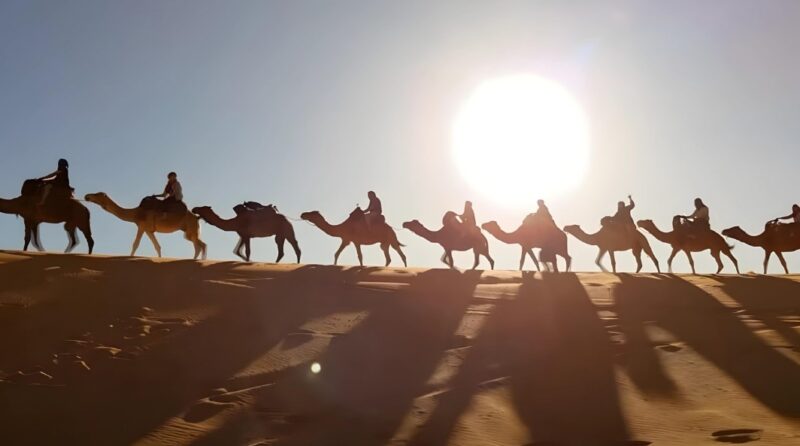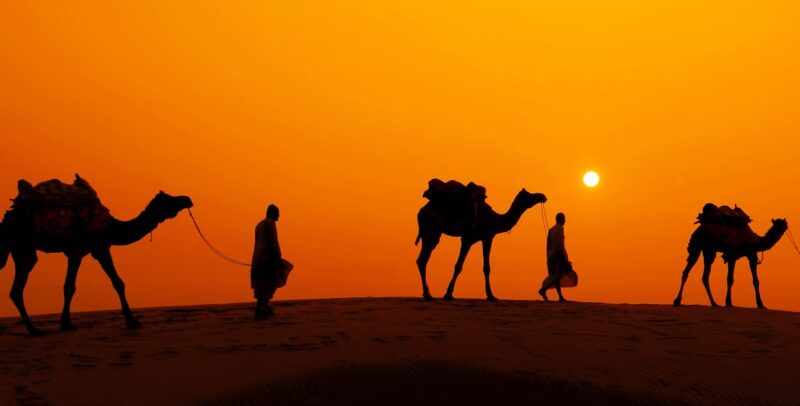Imagine a vast, sprawling sea of sand, stretching as far as the eye can see, under a scorching sun. This is the Sahara Desert, the largest hot desert in the world.
For centuries, it was not just a barrier but a route for trade, connecting different parts of Africa.
The heroes of this story are not humans but remarkable animals known for their endurance and resilience. They are camels, often called the “ships of the desert.”
In this post, I will talk about how camels became the backbone of desert trade, transforming the Sahara into a network of commerce and culture.
Key Takeaways
- Camels, known as the “ships of the desert,” were pivotal in transforming the Sahara into a vibrant trade route, carrying goods like salt and gold.
- Their unique physiological adaptations allow camels to survive in harsh desert conditions, making them indispensable for cross-desert trade.
- Camel caravans facilitated not just economic exchange but also cultural and religious spread across Africa.
- Despite modern transportation methods reducing their role in trade, camels remain a symbol of resilience and cultural heritage in desert regions.
Nature’s Gift to the Desert

Camels are extraordinary creatures uniquely equipped to navigate the challenging conditions of the Sahara that not many animals can. Their bodies are designed to withstand the extremes of desert life, from intense heat to scarce water sources.
With their ability to go for long periods without water and their feet adapted to walk on sand without sinking, camels are the perfect candidates for crossing vast deserts.
A Brief History of Camels and Trade
The use of camels for transporting goods across the Sahara dates back to around the 3rd century AD. However, it wasn’t until the Islamic expansions of the 7th and 8th centuries that camel caravans became a widespread phenomenon.
These caravans would carry salt, gold, ivory, and other precious goods across the desert, linking the Mediterranean world with Sub-Saharan Africa.
The Camel’s Adaptations to Desert Life
What makes camels so special? First, they have a unique ability to regulate their body temperature, allowing them to tolerate the heat of the day and the cold of the night.
Their humps store fat, which can be converted into water and energy, enabling them to travel great distances without food or water.
Moreover, their long, thick eyelashes and ear hairs protect them from sand, while their nostrils can close to block incoming dust.
The Role in Sahara Trade

The routes camels followed became conduits for the exchange of knowledge, religion, and art. Cities sprang up along these routes, becoming bustling centers of trade.
The introduction of camels into the Sahara trade transformed the desert from an impassable barrier to a crossroad of civilizations.
The Economic Impact of Camel Caravans
The camel caravans were the lifeline of the Sahara. They made it possible to transport goods across difficult terrain, creating wealth and fostering the growth of powerful empires in West Africa, such as Mali and Songhai.
The salt mines of the Sahara, for example, were worth their weight in gold, literally. Salt, essential for preserving food, was traded for gold, ivory, and slaves, creating a rich network of trade routes.
The Social Impact

Beyond economics, camel caravans played a crucial role in the spread of Islam and the Arabic language across the continent. They facilitated the pilgrimage to Mecca, allowing for the exchange of religious and cultural ideas.
The stories of travelers and merchants added to the rich tapestry of African history, influencing societies far beyond the desert’s edges.
The Decline
With the advent of modern transportation methods, the importance of camel caravans has diminished. Trucks and trains can now cross the desert in a fraction of the time, carrying goods more efficiently and in larger quantities.
However, in some remote parts of the Sahara, camels still play a vital role in daily life, preserving a way of life that has existed for centuries.
A Symbol of Cultural Resilience

The camel caravans of the Sahara also symbolize the resilience and adaptability of cultures faced with the most daunting of natural environments.
These caravans, traversing the vast and inhospitable desert, are a powerful reminder of how human societies have always found ways to overcome geographical barriers and connect with distant lands and peoples.
The Global Significance
The story of the Sahara’s camel caravans transcends regional history, offering a window into the ways that trade and travel can bridge vast cultural divides.
It serves as a reminder that our global heritage is rich with examples of innovation, endurance, and the relentless human spirit to explore and connect.
Final Thoughts
Camels, with their incredible adaptations and enduring strength, were the key to unlocking the riches of the Sahara. They turned a vast and hostile desert into a bridge between distant lands, fostering trade and cultural exchange that shaped the course of history.
While their role in the trade may have diminished, their legacy as the ships of the desert endure, a testament to the ingenuity of human adaptation and the extraordinary capabilities of these remarkable animals.

